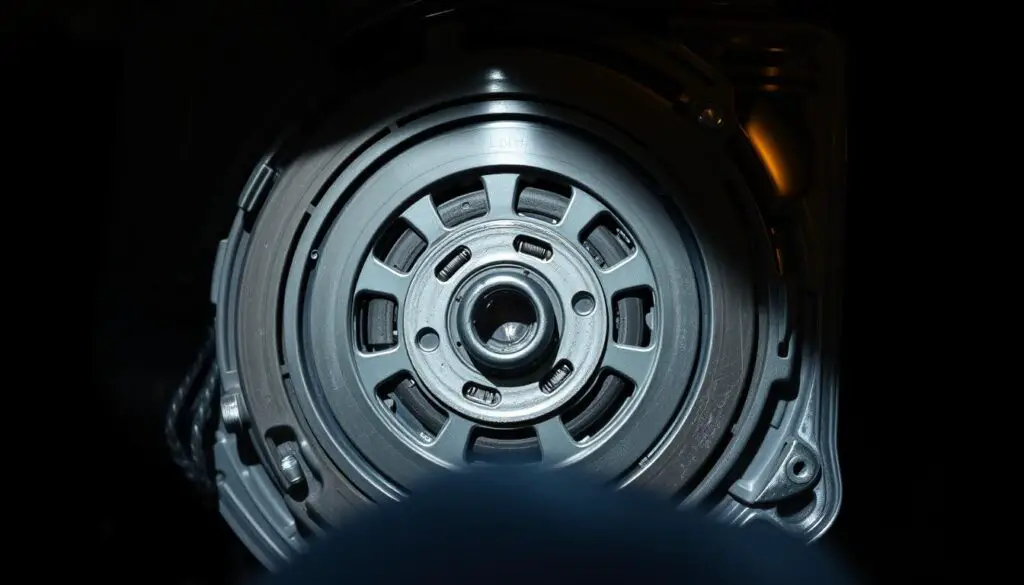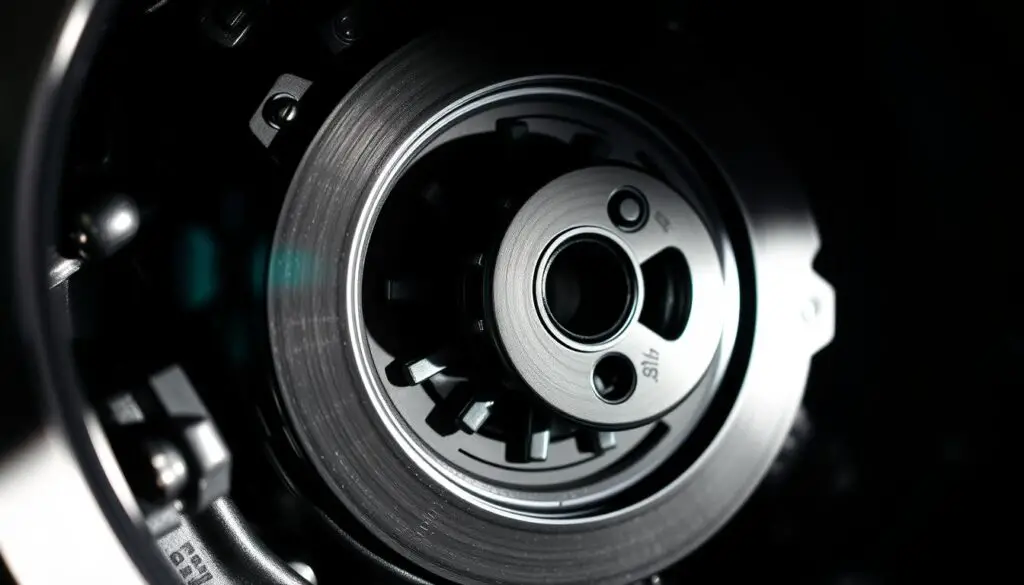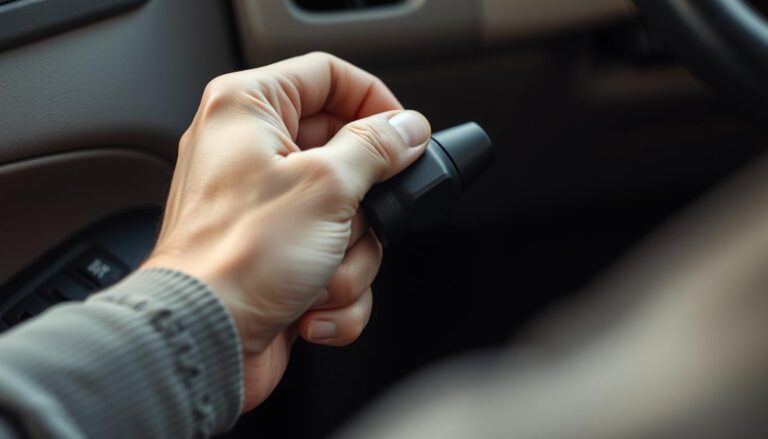Spotting a sudden change in the clutch bite can save time, money, and miles. A low bite feels like the clutch engages almost off the floor, with a light pedal and early take-up. That shift often comes with a subtle engine note change and a slight rear dip when the bite happens.
This short guide shows a safe, step-by-step way to check causes and decide if a quick driveway fix will help or if a trip to the garage is needed. We start with simple checks, move to controlled road tests, and end with clear repair choices backed by evidence — not guesses about gear selection or driver error.
Quick wins include checking floor mat interference and fluid level, then testing the bite with and without a little gas to rule out stalls. Always test on a quiet, flat road, keep the handbrake ready, and avoid forcing the bite if the car behaves unpredictably near the floor.
Key Takeaways
- Learn what a low bite feels like and why mid-travel engagement is normal.
- Perform simple checks first: floor mat, fluid level, and a controlled bite test.
- Use engine note and rear dip cues from driver training to confirm symptoms.
- Decide between a quick fix or a garage visit based on evidence, not guesswork.
- Prioritize safety: test on quiet ground, use the handbrake, and avoid forcing the pedal.
What “Very Low Biting Point” Feels Like: Quick Symptoms and Safety Notes
If the clutch grabs almost off the floor, the car will react quickly. You may feel the load with almost no pedal travel. The engine note shifts slightly the instant engagement starts.

Instructors often report a light bump at the bite and a tiny rear dip in the rear-view when the handbrake is set. That bump is a helpful cue. It shows the plates are taking strain.
Avoid finding the bite with the footbrake held hard. Using the footbrake kills the bouncing feedback you need and can make stalls more likely. Instead, use the handbrake for controlled checks on level ground.
- Hallmark: engagement near the pedal floor; car creeps as you ease off.
- Secondary signs: a spongy pedal feel, inconsistent engagement between stops, or occasional noise if parts wear.
- Unsafe cases: rollback on hills or frequent stalls when there’s little margin for gas control.
| Symptom | Visible or Audible Cue | Immediate Action |
|---|---|---|
| Near-floor engagement | Quick creep; slight engine sound change | Test on flat ground with handbrake |
| Light bump at engagement | Rear dip in rear-view | Practice find-and-hold with handbrake |
| Spongy or inconsistent pedal | Variable bite between times | Monitor after recent work; check fluid |
| Burning smell or grinding noise | Strong odor or harsh noise | Stop driving, park, set brakes, arrange tow |
How the Clutch and Biting Point Work in Real Driving

A simple model helps: two discs — one tied to the engine and one tied to the wheels — stay apart with the pedal down and meet as you lift your foot. That first contact is the bite; it lets torque flow and makes the car creep forward.
The plates, pedal, and power transfer in plain English
Press the pedal and the discs separate so gears change freely. Lift the pedal and the friction linings touch, release springs and the throw-out mechanism control how early that touch happens.
What you should feel, hear, and see at the bite
At the bite you often notice a slight engine note change and a tiny rear dip if the handbrake is set. With the view calm and steady, that dip confirms engagement without thrusting.
- Move-off sequence: set a little gas → find the bite → release the handbrake → add gas and raise the pedal smoothly.
- Why practice matters: steady release syncs engine speed and gears, cutting wear and stalls.
| Part | Feedback | Driver action |
|---|---|---|
| Friction disc | Note change, light creep | Ease pedal; add gas |
| Release springs | Early or late bite | Check adjustment or wear |
| Throw-out bearing | Noise when engaging | Inspect for replacement |
Clutch Biting Point Very Low: Understanding Your Vehicle’s Clutch System
Normal wear and real-world use slowly move where the pedal first grabs. Over years and miles the friction lining thins and diaphragm springs lose some bite. These changes shift engagement a little or a lot, depending on driving style.
Why the engagement shifts over time
Heat, stop-and-go traffic, towing, and repeated slip speed up wear. Minor changes in release geometry inside the part stack also nudge the point. Small hydraulic air or fluid changes can move the feel day to day.
Common myths vs real behavior
Myth: A powerful engine always ruins a clutch fast. Fact: technique, conditions, and load matter more.
“A slight rear dip and a soft engine note at the touch are usually normal; burning smells, chatter, or sudden full-floor engagement are not.”
| Cause | Usual sign | When to act |
|---|---|---|
| Friction wear / spring fatigue | Earlier bite, more creep | Plan inspection |
| Heat or towing | Transient slip or change | Avoid heavy loads; monitor |
| Hydraulic aeration | Wandering bite | Bleed system; check fluid |
- If the bite wanders day to day, test after a cold start and after warm-up.
- Persistent rapid shifts or hard gear selection mean a garage visit is wise.
Before You Wrench: Simple Driveway Checks You Can Do First
Before lifting the car or ordering parts, run a short set of driveway checks. These take minutes and often reveal the cause of an early bite or wandering feel at the pedal.
Pedal free play, floor mats, and shoe control
Verify nothing blocks pedal travel. Re-seat the floor mats and check the carpet underlay near the pedal. Thick or pointy shoes reduce feel; keep the heel lightly on the floor so the foot can modulate precisely.
Press and release the pedal with the car off to check for smooth return and consistent resistance. Note any roughness, sticking, or odd side play at the pedal box.
Fluid level and condition (hydraulic systems)
Inspect the reservoir for low or dark fluid. Air in the lines makes the pedal spongy and moves the bite lower.
- Look for dampness at the master, slave, and along lines — external weeping means air can enter.
- If fluid looks contaminated or low, a bleed often restores normal feel.
- Check gear selection at idle; difficulty changing gears can point to hydraulic or linkage faults rather than friction wear.
Decide next steps. If a mat, shoe change, or bleeding restores a normal way the pedal reaches the bite, you saved miles and money. If not, the checks will give clear evidence to share with a technician.
Road Test to Confirm: Finding, Holding, and Moving Off from the Bite
Perform tests on quiet, level pavement first. This reveals whether the pedal engages near the floor or at mid-travel. Keep the handbrake ready and conduct each step slowly.
Flat-road check with and without gas
Without gas, slowly lift the pedal until the engine note changes and the car begins to load. Note the exact travel where that happens; this builds sensitivity of the foot.
Repeat with a small steady gas input. If the car still grabs almost at the floor, record how little lift is required before the car creeps forward.
Gentle uphill hold using handbrake
On a mild incline, set a little gas and bring the pedal to the bite while holding the handbrake. Look for the slight rear dip in your view as confirmation.
Release the handbrake—if the car holds and moves smoothly, the engagement is consistent; if it rolls or stalls, note the behavior for the garage.
Low-speed traffic simulation and consistency checks
Simulate stop‑and‑go by nudging to the bite and coasting at walking pace. Avoid prolonged partial engagement to prevent heat and wear.
- Track consistency across times: a bite that shifts from floor to mid-travel suggests air or thermal effects, not only wear.
- Note any shudder, hard gear selection, or stalls—these steer the next diagnostic step and whether you should drive on or visit the garage.
“Set gas → find the bite → release the handbrake → add gas → raise the pedal smoothly.”
| Test | What to watch | Action |
|---|---|---|
| Flat no-gas | Engine note change, exact travel | Record feel |
| Flat with gas | Amount of pedal lift before creep | Compare to no-gas |
| Uphill hold | Rear dip, hold vs. roll | Decide safety to drive |
Hydraulic Issues That Lower the Biting Point
Hydraulic faults often hide behind a soft pedal and an engagement that drifts toward the floor. Air ingress or fluid leaks at the master or slave allow pressure to fall, so the clutch releases later and the bite sits lower.
Master and slave leaks, air ingress, and spongy pedal
When the master or slave cylinder fails, fluid can escape or air can be drawn in. This reduces hydraulic pressure and makes the clutch pedal feel spongy.
Typical signs include a progressively lower engaging point, a soft pedal, and take-up that changes after the car warms up or sits overnight.
Bleeding the system and when to replace cylinders
Start with quick checks: confirm fluid level, inspect the firewall, lines, and slave for damp spots, and see if pumping the pedal briefly raises the bite.
- Bleed at a glance: open the bleed nipple, pump slowly, close when clear fluid appears and no bubbles remain.
- When to replace: recurring aeration, visible seepage, or an old cylinder with years and miles on it means replacement, not repeated bleeds.
Hydraulic faults can mimic worn parts. A key clue is engagement height changing day to day or during a single drive.
“If gears grind or release is incomplete, stop driving and arrange a tow—forcing it risks transmission damage.”
| Issue | Symptom | Action |
|---|---|---|
| Air in lines | Spongy pedal, wandering bite | Bleed system; retest |
| Master/slave leak | Fluid loss, damp spots | Replace cylinder; re-bleed |
| Intermittent pressure | Engagement shifts with heat | Inspect lines and components |
Final check: after hydraulic work, perform a short drive test. A stable point and smooth bite confirm the repair before normal use.
Mechanical Causes Within the Clutch Assembly
A worn pressure plate spring can change how and where the pedal first lets torque through.
Diaphragm spring fatigue lowers clamp force. Even with lining still on the disc, a weak spring shifts the bite and can allow slip under load. That explains why a car may feel old despite visible material.
Worn springs, release bearing, and friction disc
Release bearings that wear or bind change travel and may cause noisy or abrupt engagement. A tired cover or broken finger alters the pedal‑to‑engage relationship and creates odd feel or noise.
New clutch break‑in versus installation faults
A new clutch can bite low while surfaces bed together. Normal break‑in smooths this within a few miles. Faults like wrong preload, misadjusted linkage, or a warped flywheel produce persistent grabby or low engagement and need rework at the garage.
- Flywheel glaze/runout: can give a grabby bite and should be surfaced or replaced.
- Document noise, rpm flare, or engagement shifts to help technicians diagnose pressure, release, or disc issues.
- Re‑test after repair over several miles to confirm the biting point stabilizes near mid‑travel.
Pedal Box, Cables, and Linkage Problems
A tiny change at the foot or floor can produce a large shift at the fork and alter when the disc starts to grip.
Pedal pivot wear, cracked brackets, or weak return springs reduce effective travel. That loss of travel can make the bite sit closer to the floor and make the car harder to modulate.
Pivot wear, bracket flex, and return spring issues
Check for side‑to‑side wobble, squeaks, or a rough stroke. These signs point to worn bushes or a cracked bracket. A weak return spring lets the pedal rest lower and cuts usable travel.
If cable‑equipped: stretch, adjustment, and replacement
Cables can stretch, bind, or fray after years of use. Stretch increases free play and lowers the biting point until you adjust or replace the cable. Binding creates a notchy feel and inconsistent bite while driving.
- Quick checks: wiggle the pedal, listen for rubbing, inspect the cable sheath and bulkhead for flex.
- Small pedal changes at the floor can translate into large fork movement at the clutch.
- Adjust where you can; replace when play returns or parts show wear from years.
After any work, test on flat ground. Use proper foot technique: heel lightly on the floor and deliberate modulation. Confirm a stable bite and smooth gear selection before normal driving.
Noises, Smells, and Feel: Sensory Clues That Pinpoint the Problem
Smells, sounds, and small motions tell a clear story about wear and pressure loss. Use what you hear and smell to decide if the issue is a simple adjustment or a part that needs replacement.
Grinding gears, a bump, and hot, burning odors
Look for grinding when you select a gear. That often means incomplete release and can signal hydraulic or linkage faults.
A sharp bump or jolt as you lift the pedal can point to worn springs or glazed surfaces.
A hot, burning smell after repeated launches or holding on the bite means excessive slip. Stop testing if the odor appears.
Engine note and rear dip as useful feedback
At the engagement you should notice a subtle engine note change and a tiny rear dip when the handbrake is set. These are repeatable markers to find the exact spot.
Do not use the footbrake for these checks; it masks motion cues and raises stall risk. The handbrake keeps the view reliable.
- Sensory red flags: gear grind, bump on rise, burning smell after holds.
- A low bite plus grinding often means incomplete release from air or linkage issues.
- A high‑rev flare with odor suggests pressure loss or glazing on the friction faces.
- Different noises hot vs. cold help separate bearing faults from pack wear or aeration.
| Signal | Likely cause | Recommended action |
|---|---|---|
| Grinding selecting gears | Incomplete release (hydraulic or linkage) | Inspect fluid, bleed or adjust; limit driving |
| Burning smell after holds | Excessive slip or glazing | Stop testing; cool down; inspect friction parts |
| Sudden engagement or chatter | Surface damage or spring fault | Plan component inspection and possible replacement |
| Smooth but ultra-low bite | Likely hydraulic pressure change | Check master/slave, reservoir, and lines |
Record when noises or smell occur, how long they last, and any pedal change. This log helps a technician find the root cause quickly. If release feels inconsistent or burning recurs, stop aggressive testing and move to corrective steps to protect parts.
Fix Paths: From Easy Adjustments to Full Clutch Replacement
Sort repair choices into three clear paths: simple fixes, hydraulic work, and full replacement. This saves time and avoids unnecessary parts swaps.
When a bleed or adjustment is enough
Start with no-cost, low-cost steps. Remove mats, check cable free play if fitted, and top or change fluid if it is dark. If the pedal feels spongy or the bite wanders, a careful bleed often restores normal feel.
When to book the garage for a clutch kit
Book professional help when fluid loss or repeated aeration returns, or when noise, grinding into gear, or a sudden change in the engagement point persists.
- Success for minor fixes: stable bite near mid‑travel, smooth take‑offs, and clean gear selection without odor or grind.
- Replace a leaking master or slave cylinder when seals fail—this fixes pressure without opening the bellhousing.
- Order a full kit (clutches, cover, release bearing, flywheel work) if springs are weak, the disc is glazed, or parts show heat damage.
“Set gas → find the bite → release handbrake” is a repeatable check. If that fails after bleeding, schedule a garage visit.
After any repair, re-run the bite tests. If the car passes consistently across drives, the job is done. If not, a technician should inspect parts and diagnose the root cause before more work.
Driving Technique Reset: Relearning the Bite to Protect the Clutch
Relearning a simple move-off sequence helps drivers control the car with less clutch heat. Small, deliberate changes to timing and footwork stop stalls and cut wear.
Set gas, find the bite, release the handbrake
Follow this sequence: set a light, steady gas → find the bite → release the handbrake → add more gas → raise the pedal smoothly.
Instructors often coach learners to practice the feel without gas first. This sharpens the foot so adding throttle later becomes natural and reliable.
Hill starts and holding without riding
On an incline use the handbrake to stop rollback, then reach the bite and release the brake once the car holds. Avoid keeping the disc partially gripped for long periods; it overheats and smells.
Return your foot fully off the pedal between shifts. Small, coordinated inputs to gas and the release reduce grind and sudden hops.
- Practice without gas on level ground, then add gas for real traffic.
- Keep the heel lightly on the floor as a pivot for precise millimeter control.
- Avoid overlapping heavy gas with a fast release—too fast causes a hop; too slow causes heat.
| Situation | Technique | Why it helps |
|---|---|---|
| Flat start (no traffic) | Find bite first, then add gas | Builds pedal feel without risk |
| Real-world pull-away | Set light gas, find bite, release handbrake | Quicker, safer starts into gaps |
| Uphill hold | Handbrake assist; brief time at bite only | Prevents rollback and limits wear |
| Stop-and-go traffic | Short nudges at bite, alternate with coasting | Minimizes clutch time at partial engagement |
Footwear and Footwork for Precise Clutch Control
Flat, thin‑soled shoes and a steady heel pivot make it easier to sense the first hint of engagement. Good footwear increases feel and reduces overcorrection when you find the bite.
Small habit changes at the foot can cut stalls and wear. Position your heel lightly on the floor so the contact point on the pedal stays fixed. Let the heel slide a little as you lift so each touch is consistent.
Practical tips for better control
- Choose flat, thin soles: they transmit feedback so you sense the exact bite and modulate with confidence.
- Avoid bulky or pointy shoes: heavy boots and sharp toes dull feel and can catch under trims, upsetting the way you release the clutch.
- Heel placement: use the floor as a pivot during the approach, then lift fully past engagement to avoid riding the disc.
- Build ankle memory: repeat find‑and‑hold drills on quiet roads to train precise millimeter control for gear take‑offs.
- Check mats and soles: worn or slick floor coverings change traction and can shift feel over time.
Use technique to separate faults from hardware issues. If precise footwork does not improve control of the car, the low bite likely points to a mechanical or hydraulic problem and needs inspection.
Preventive Care: Keep the Biting Point Consistent Over Time
Small, frequent checks of fluid and linkage keep the bite predictable through years of use.
Inspect fluid and the hydraulic circuit at regular intervals. Replace aged fluid to cut aeration that moves the engagement lower. Check the master and slave cylinder for damp spots and local leaks.
Fluid checks, service intervals, and avoiding heat and slip
Track service by years and miles. Schedule reservoir checks when you change oil or brakes. Old fluid and trapped air often show as a wandering feel or a soft pedal.
Listening to engine and pedal feedback in traffic
Use short nudges at the bite and coast rather than holding partial engagement in queues. This limits heat and glazing and preserves power transfer during repeated moves.
- Keep footwear thin‑soled and consistent; it helps repeatable feel.
- On long descents, use gears and brakes instead of slipping at the bite.
- After work on the slave cylinder, validate the location with controlled tests on level ground.
“Preventive checks cost little time but stop small faults turning into garage visits.”
| Action | Why | When |
|---|---|---|
| Replace hydraulic fluid | Reduces aeration, stabilizes engagement | Every 2 years or as service manual advises |
| Inspect master/slave | Find leaks before pressure loss | At fluid change or if pedal wanders |
| Technique drills | Reduce wear and stalls | Weekly practice in low traffic |
Conclusion
Conclusion
Finish with a clear plan: rule out simple causes, confirm behaviour on the road, then choose the right repair path.
Start by checking floor mats, footwear, and foot position. Then test the bite using the set‑gas → find → release handbrake sequence to keep the car steady and avoid stalls.
Watch cues at engagement: an engine note shift, a tiny rear dip, and pedal feel help separate technique issues from real mechanical problems.
If fluid checks, linkage tweaks, or a bleed do not fix things, inspect hydraulic parts and internal components. If grinding or hot odors appear after miles of testing, book a garage for a professional diagnosis.
Disciplined technique plus timely maintenance keeps engagement consistent, protects parts, and makes every gear change smooth and predictable.
FAQ
What does a very low biting point feel like when driving?
You’ll notice the pedal engages much closer to the floor than before. The car may creep slowly with little pedal travel, or it may stall easily because the engagement zone is tiny. You might also feel a soft or spongy pedal if hydraulic parts are involved.
Can a new replacement behave like this at first?
Yes. A freshly fitted friction disc and pressure plate often need a short break‑in. However, if the engagement stays unusually low after several hundred miles, installation issues or incorrect linkages may be the cause.
Which simple driveway checks should I do before calling a garage?
Check pedal free play and the position of any floor mats. Inspect footwear and seating position. For hydraulic systems, check reservoir fluid level and look for obvious leaks under the car. These quick steps catch many avoidable problems.
How do I safely test the engagement point on the road?
On flat ground, in a quiet area, hold the handbrake, select first gear, find the engagement with light revs, then release the handbrake to feel how the car moves. Repeat a gentle uphill hold test to confirm consistency. Don’t force it in traffic.
What hydraulic faults produce a low engagement point?
Leaking master or slave cylinders, air in the lines, or a deteriorated hose can lower the engagement. These cause extra pedal travel and a soft feel. Bleeding or replacing failed cylinders usually restores correct travel.
When is bleeding the system enough versus replacing parts?
If the pedal is spongy after a bleed or if there’s visible leakage at a cylinder or hose, replacement is needed. Bleeding fixes air ingress; it won’t cure worn seals or cracked components.
What mechanical wear inside the assembly leads to low engagement?
A worn friction disc, weak pressure‑plate springs, or a damaged release bearing reduce the contact area and change where engagement occurs. These faults often cause slip, smell of burning, or poor power transfer.
Could linkage, pedal box, or cable faults cause this symptom?
Yes. Pedal pivot wear, loose brackets, or a stretched cable alter pedal travel and engagement position. On cable systems, simple adjustment or replacement often fixes the problem. On hydraulic cars, look for pedal play and return‑spring issues.
What sensory clues point to major internal damage?
Grinding when engaging, a pronounced clutch bump, persistent burning smell, or loud engine revs with little acceleration indicate serious internal wear or slipping. Those signs mean book the garage sooner rather than later.
How can I adjust my driving to protect the system until it’s repaired?
Use a clear sequence: set throttle, find the engagement gently, and release the handbrake smoothly. Avoid riding the pedal, and use the handbrake for hill holds. Short, precise releases and avoiding slipping reduce heat and wear.
What footwear gives the best pedal feel and control?
Thin‑soled, flat shoes provide the best feedback. Avoid thick‑soled or heavy boots and pointy toes that reduce sensitivity. Proper heel placement and steady ankle control help you find and hold the engagement reliably.
When should I book a full replacement rather than try adjustments?
Book a garage if you detect persistent slipping, burning smells, metal noises, visible leaks, or if adjustments and bleeding don’t restore normal pedal travel. High mileage, worn parts, or failed hydraulics typically require a kit and professional fitment.
How often should I check fluid and perform preventive care?
Check reservoir level at every service or at least every few months. Follow manufacturer service intervals for fluid changes and inspections. Regular checks catch seal deterioration and reduce the chance of sudden engagement problems.


